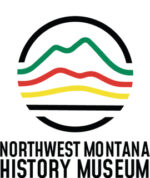On a Passing Frontier
Explore the Earliest Stories from Northwest Montana.
The railroad through Kalispell was completed in 1892, but people have been in the Flathead Valley for over 6000 years.
Today, people from all over come to hunt, fish, and gather food in Kalispell and the surrounding area.
The region also served as a valuable resource for Northwest Montana’s American Indian tribes.
They hunted with bow and arrow, constructed traps for trout, and spear fished for salmon.
Nothing was wasted; lodges and clothing were primarily made with skins and hides from game animals.
It is true that the world has changed a great deal since the “golden age” of the American Indian.
By preserving, remembering, and sharing these cultures that so shaped Northwest Montana, we all do our part to ensure that these traditions and values remain alive today and into the future.
As the nineteenth century progressed, the Flathead Valley (which was the last place in the lower 48 states to be permanently settled) began to attract more and more people, first with trading and trapping, and later with the lumber and mining industries.
Frank Bird Linderman is perhaps the best example of the “Old West Montana” personified.
He evolved as the state did, constantly shifting his profession and lifestyle to keep pace with the growing territory (Linderman’s arrival predated the state of Montana).
Today, Frank Bird Linderman is best remembered for his work with western American Indian tribes: personally, professionally, and politically.
Linderman understood the importance of collecting and recording these stories and traditions, and he made this passion his life’s work.
As he did so, Linderman himself became an important fixture in Montana’s history.
